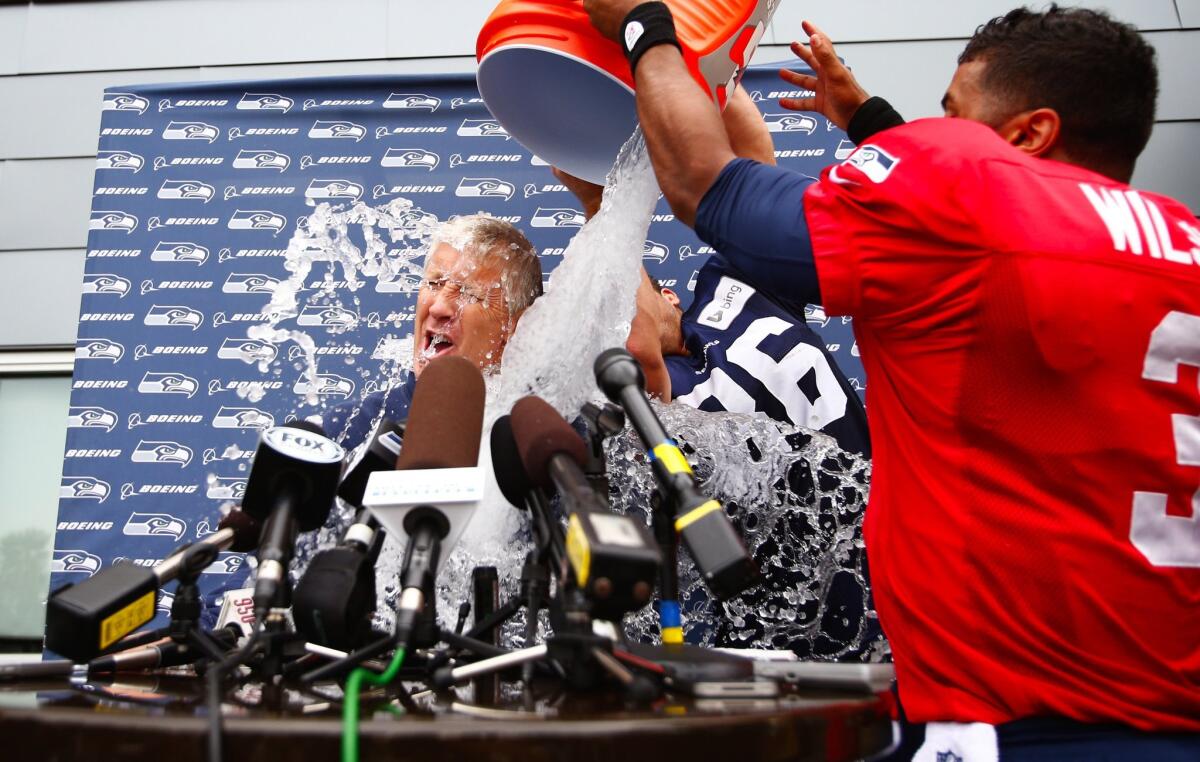A few (impolite) questions about the ice bucket challenge

Americans are probably not unique in the world in treating philanthropy as a sort of game, with the goal of making it go down painlessly.
The ice bucket challenge sweeping the nation--or at least those parts of it accessible by Facebook and Twitter--is another example of how that system works. Itâs a system that includes credit card companies making a Christmastime donation to a charity every time you charge a purchase, or shoe companies sending a pair to Africa every time you buy one for yourself, or your pledging some money for every mile that someone else runs or swims to support research into a disease cure.
On the surface thereâs nothing wrong with any of this, since every dollar donated means one dollar more. But deeper down, there are lots of problems with it, and the ice bucket challenge illustrates why.
The challenge, as you may know, benefits the ALS Association, which supports research into the degenerative condition amyotrophic lateral sclerosis, or Lou Gehrigâs disease.
As described by the association, the challenge âinvolves people getting doused with buckets of ice water on video, posting that video to social media, then nominating others to do the same, all in an effort to raise ALS awareness. Those who refuse to take the challenge are asked to make a donation to the ALS charity of their choice.â (The commonly suggested donation is $100.)
Plainly, thereâs something of a perverse incentive here. Those pictured on Facebook or Twitter dousing themselves with ice water are ostensibly people who refused to donate.
But since dozens of celebrities have made videos of themselves getting doused--Matt Lauer, Mike Trout, Martha Stewart, etc.--we can assume that the principle has been turned around. The challenge has morphed into a device for increasing awareness and therefore fundraising for ALS research. It appears to be quite successful, since the association says itâs received $15.6 million in donations since July 29, compared with $1.8 million in the same period last year.
The first issue raised by the ice bucket challenge is whether this money is being put to its best use. Thatâs not a rap on the ALS Association, which appears to get good marks on philanthropic efficiency. Nor is it about whether ALS warrants this level of attention and charitable giving. Itâs whether ALS warrants the attention, compared with other possible charitable causes.
Letâs stipulate that ALS is a devastating condition for those who have it. Itâs almost invariably fatal, with most victims living two to five years after symptoms first appear, according to the Centers for Disease Control and Prevention. Researchers are still struggling to understand it.
But ALS is also a rare disease, which is defined by the federal Rare Diseases Act of 2002 as one affecting fewer than 200,000 patients nationwide. The CDC estimates the prevalence of ALS in the U.S. at any one time at about 12,000 persons. The ALS Association says 30,000, but hasnât responded to my inquiry about the discrepancy.
Even taking the ALS Association figure, the prevalence of the disease is far outstripped by many other conditions that also could benefit from more research funding. These include Alzheimerâs (an estimated 5.2 million patients in the U.S.), and diabetes (25.8 million).
Stunt philanthropy like the ice bucket challenge doesnât accommodate such distinctions and comparisons--it just feeds whatever charity hits on a catchy device and treats all causes as essentially equivalent, distinguished only by their momentary claim on public attention. The result is that âthe most successful charities will be those that are best at soliciting funds, not those that are best at making the world a better place,â as the British philanthropic organizer William MacAskill puts it.
Itâs a fair guess that most people prompted by ice bucket publicity to make a donation donât know much about ALS beyond the fact that Lou Gehrig got it (maybe they know about Stephen Hawking, too). They may assume that itâs a major public health problem, though the numbers say itâs not.
That would be all right if new donations to ALS added to the total of charitable giving. But the evidence is to the contrary. One concern of philanthropy experts is that high-profile fundraising campaigns like this might cannibalize other donations--those inclined to donate $100 to charity this summer, or this year, will judge that theyâve met their social obligations by spending the money on ALS. (See this piece by MacAskill for an explanation.)
The explosive spread of the ice bucket challenge could even end up hurting ALS fundraising in the long term. The challenge is a fad, and fads by their nature burn out--the brighter they glow, the sooner they disappear.
The hard work of philanthropy always lies in creating a sustainable donor base. But the ice bucket challenge has all the hallmarks of something that will be regarded in 2015 as last yearâs thing.
Even today the connection between the ice bucket videos and ALS seems tenuous--think about how many times you heard about the âice bucket challengeâ or saw the hashtag #icebucketchallenge on Twitter before you had any idea that it was associated with ALS. The ALS Association may be very pleased with its haul of donated cash this summer, but hereâs betting that next yearâs collections will be closer to last yearâs than this yearâs.
So, sure. You want to contribute to the fight against ALS, great. But if youâre doing it just because you saw or heard about Bill Gates, Jimmy Fallon, Justin Timberlake or Ethel Kennedy dumping ice water on their head, maybe you should give a bit more thought to where you donate your money.
Keep up to date with The Economy Hub by following @hiltzikm.
More to Read
Inside the business of entertainment
The Wide Shot brings you news, analysis and insights on everything from streaming wars to production â and what it all means for the future.
You may occasionally receive promotional content from the Los Angeles Times.











